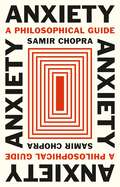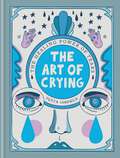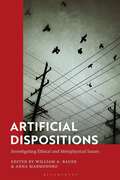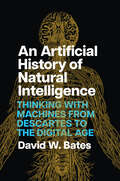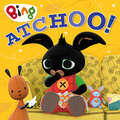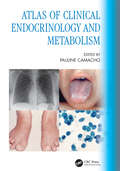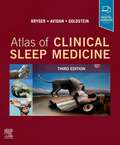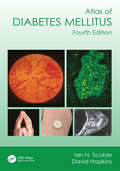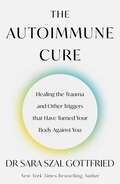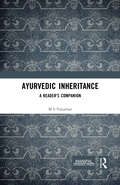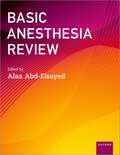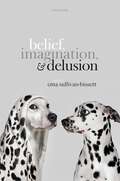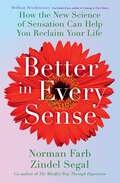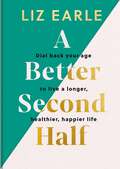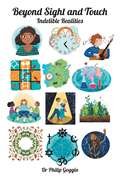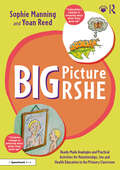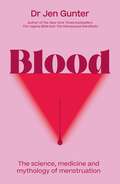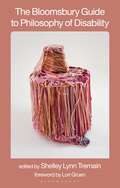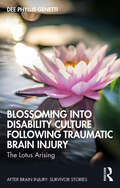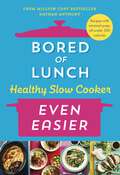- Table View
- List View
Anxiety: A Philosophical Guide (Moral Psychology Of The Emotions Ser.)
by Samir ChopraHow philosophy can teach us to be less anxious about being anxious by understanding that it&’s an essential part of being humanToday, anxiety is usually thought of as a pathology, the most diagnosed and medicated of all psychological disorders. But anxiety isn&’t always or only a medical condition. Indeed, many philosophers argue that anxiety is a normal, even essential, part of being human, and that coming to terms with this fact is potentially transformative, allowing us to live more meaningful lives by giving us a richer understanding of ourselves. In Anxiety, Samir Chopra explores valuable insights about anxiety offered by ancient and modern philosophies—Buddhism, existentialism, psychoanalysis, and critical theory. Blending memoir and philosophy, he also tells how serious anxiety has affected his own life—and how philosophy has helped him cope with it.Chopra shows that many philosophers—including the Buddha, Kierkegaard, Nietzsche, Freud, and Heidegger—have viewed anxiety as an inevitable human response to existence: to be is to be anxious. Drawing on Karl Marx and Herbert Marcuse, Chopra examines how poverty and other material conditions can make anxiety worse, but he emphasizes that not even the rich can escape it. Nor can the medicated. Inseparable from the human condition, anxiety is indispensable for grasping it. Philosophy may not be able to cure anxiety but, by leading us to greater self-knowledge and self-acceptance, it may be able to make us less anxious about being anxious.Personal, poignant, and hopeful, Anxiety is a book for anyone who is curious about rethinking anxiety and learning why it might be a source not only of suffering but of insight.
The Art of Crying: The healing power of tears
by Pepita SandwichExplore the healing, transformative power of shedding tears in this evocatively illustrated study of crying, one of the most uniquely human things we do.What if crying wasn't just an involuntary reaction to feeling sad, vulnerable, or overwhelmed - but a hidden wellspring of power we could harness to live a fuller life? In The Art of Crying, Pepita Sandwich makes the case that crying is humanity's most misunderstood and magical special effect. We are the only animals who shed tears as a result of the emotions we feel. But crying is not our weakness: it's our superpower. Our tears are a path to growth and healing that leads to deeper and more fulfilling experiences. In this beautifully illustrated book, Sandwich dives deep into an ocean of research into tears to understand the science and history of this uniquely human phenomenon. And she has emerged with a case for "letting it all out" a little more often, because tears have a powerful magic all their own.
Artificial Dispositions: Investigating Ethical and Metaphysical Issues
by William A. Bauer and Anna MarmodoroWe inhabit a world not only full of natural dispositions independent of human design, but also artificial dispositions created by our technological prowess. How do these dispositions, found in automation, computation, and artificial intelligence applications, differ metaphysically from their natural counterparts? This collection investigates artificial dispositions: what they are, the roles they play in artificial systems, and how they impact our understanding of the nature of reality, the structure of minds, and the ethics of emerging technologies. It is divided into four parts covering the following interconnected themes: (i) Artificial and Natural Dispositions, (ii) Artificial Systems and Their Dispositions, (iii) Agency, Mind, and Artificial Dispositions, and (iv) Artificial Moral Dispositions. This is a groundbreaking and thought-provoking resource for any student or scholar of philosophy of science, contemporary metaphysics, applied ethics, philosophy of mind, and philosophy of technology.
An Artificial History of Natural Intelligence: Thinking with Machines from Descartes to the Digital Age
by David W. BatesA new history of human intelligence that argues that humans know themselves by knowing their machines. We imagine that we are both in control of and controlled by our bodies—autonomous and yet automatic. This entanglement, according to David W. Bates, emerged in the seventeenth century when humans first built and compared themselves with machines. Reading varied thinkers from Descartes to Kant to Turing, Bates reveals how time and time again technological developments offered new ways to imagine how the body’s automaticity worked alongside the mind’s autonomy. Tracing these evolving lines of thought, An Artificial History of Natural Intelligence offers a new theorization of the human as a being that is dependent on technology and produces itself as an artificial automaton without a natural, outside origin.
An Artificial History of Natural Intelligence: Thinking with Machines from Descartes to the Digital Age
by David W. BatesA new history of human intelligence that argues that humans know themselves by knowing their machines. We imagine that we are both in control of and controlled by our bodies—autonomous and yet automatic. This entanglement, according to David W. Bates, emerged in the seventeenth century when humans first built and compared themselves with machines. Reading varied thinkers from Descartes to Kant to Turing, Bates reveals how time and time again technological developments offered new ways to imagine how the body’s automaticity worked alongside the mind’s autonomy. Tracing these evolving lines of thought, An Artificial History of Natural Intelligence offers a new theorization of the human as a being that is dependent on technology and produces itself as an artificial automaton without a natural, outside origin.
ATCHOO! (Bing)
by HarperCollins Children’s BooksA wonderful new picture book about Bing catching a cold based on the award-winning animated series Bing!
Atlas of Clinical Endocrinology and Metabolism
by Pauline CamachoThis updated text is a pictorial atlas of endocrine and metabolic disorders. Each chapter focuses on providing multiple illustrations as well as a thorough discussion of the diagnosis and management of a variety of endocrine diseases with their appropriate treatment plans. Using updated guidelines, it provides a comprehensive discussion of the latest therapies, including diabetes technology. Presenting a large number of clinical images, including imaging of thyroid ultrasounds, DXA images, bone scans, and new technologies in diabetes mellitus, this atlas aims to provide the reader with the information needed to make accurate diagnoses, making it an updated source of highly illustrated information for endocrinologists, clinicians, residents, fellows and trainees. With new chapters on transgender medicine and obesity, this textbook is a valuable resource for the contemporary endocrine practitioner. • Features new chapters such as transgender medicine and inborn errors of metabolism • Aims to be an invaluable aid for endocrinologists, internal medicine specialists, family practice clinicians, residents, fellows, and trainees • Explores diabetes technology with updated guidelines
Atlas of Clinical Endocrinology and Metabolism
This updated text is a pictorial atlas of endocrine and metabolic disorders. Each chapter focuses on providing multiple illustrations as well as a thorough discussion of the diagnosis and management of a variety of endocrine diseases with their appropriate treatment plans. Using updated guidelines, it provides a comprehensive discussion of the latest therapies, including diabetes technology. Presenting a large number of clinical images, including imaging of thyroid ultrasounds, DXA images, bone scans, and new technologies in diabetes mellitus, this atlas aims to provide the reader with the information needed to make accurate diagnoses, making it an updated source of highly illustrated information for endocrinologists, clinicians, residents, fellows and trainees. With new chapters on transgender medicine and obesity, this textbook is a valuable resource for the contemporary endocrine practitioner. • Features new chapters such as transgender medicine and inborn errors of metabolism • Aims to be an invaluable aid for endocrinologists, internal medicine specialists, family practice clinicians, residents, fellows, and trainees • Explores diabetes technology with updated guidelines
Atlas of Clinical Sleep Medicine E-Book: Expert Consult - Online
by Meir H. KrygerEasy to read and richly illustrated, Atlas of Clinical Sleep Medicine, 3rd Edition, provides the tools you need to accurately diagnose and treat the full range of adult and pediatric sleep disorders. Dr. Meir H. Kryger and a team of expert contributing authors detail the physiologic, clinical, morphologic, and investigational aspects of the sleep disorders you encounter in everyday practice—enhanced by high-quality images throughout. This highly regarded, award-winning atlas is an ideal resource for sleep practitioners and technicians in the lab, as well as an effective review for certification and recertification. Features a thoroughly illustrated, reader-friendly format that highlights key details, helping you interpret the visual manifestations of your patients’ sleep disorders so you can manage them most effectively. Contains the most up-to-date drug therapy with information about the latest drugs available as well as those in clinical trials. Provides greater coverage of pediatric and adolescent disorders, including behavioral insomnia, new medication options, and multiple sleep latency testing (MSLT) specific to children. Includes current AASM scoring guidelines and diagnostic criteria. Presents correlations between normal and abnormal sleep relative to other health issues such as stroke and heart failure. Illustrates the physiology of sleep with full-color images (many are new!) and correlates the physiology with the relevant findings. Provides numerous resources online, including more than 80 patient interview and sleep lab videos and 200+ polysomnogram fragments.
Atlas of Diabetes Mellitus
by Ian N. Scobie David HopkinsThis completely revised and updated Fourth Edition of the Atlas of Diabetes Mellitus provides a broad coverage of all aspects of diabetes mellitus and an extensive collection of common and rare clinical images. It aims to provide an invaluable resource for anyone interested in the management of this ubiquitous clinical condition including primary care/ family physicians, endocrinologists, physicians in training, diabetic specialist nurses and other key professionals who are likely to be involved in the care of patients with diabetes mellitus.
Atlas of Diabetes Mellitus
by Ian N. Scobie David HopkinsThis completely revised and updated Fourth Edition of the Atlas of Diabetes Mellitus provides a broad coverage of all aspects of diabetes mellitus and an extensive collection of common and rare clinical images. It aims to provide an invaluable resource for anyone interested in the management of this ubiquitous clinical condition including primary care/ family physicians, endocrinologists, physicians in training, diabetic specialist nurses and other key professionals who are likely to be involved in the care of patients with diabetes mellitus.
The Autoimmune Cure: Healing The Trauma And Other Triggers That Have Turned Your Body Against You
by Sara GottfriedNew York Times bestselling author Dr Sara Szal Gottfried reveals how trauma can rewire your body to trigger autoimmune diseases - and provides a comprehensive plan to reset your immune system and finally healWe know that autoimmune disease - a condition when the body's immune system attacks its own healthy tissue and cells - affects millions of people worldwide. But as New York Times bestselling author Dr Gottfried explains in this eye-opening new book, autoimmune disease may be even more pervasive than we realise - and its cause may surprise you.Conventional medicine falls short when it comes to both diagnosing and treating autoimmune disease. Many people suffer from mysterious symptoms like severe fatigue, brain fog, aches and pains, feelings of tingling and numbness, stubborn weight gain, abdominal pain, digestive problems, hair loss, insomnia, and even anxiety, and don't realize their immune system is at the root of their symptoms. In her precision medicine practice, Dr Gottfried noticed a seemingly unusual pattern: many of her patients who suffer from autoimmune disease and symptoms have a history of trauma. Emerging research shows that up to 80 per cent of patients with autoimmune disease experienced significant emotional distress before getting sick.With The Autoimmune Cure, there is hope on the horizon for the tens of millions of people who suffer from autoimmune disease. Dr Gottfried has created a powerful programme designed to break the vicious cycle of autoimmune disease, reset your immune system and restore your health, with advice on diet, sleep, supplements, breathwork, microbiome restoration, somatic therapy and much more.The Autoimmune Cure offers a road map to lasting relief from autoimmune disease by addressing the underlying cause of the condition and healing the body, mind and spirit.
Ayurvedic Inheritance: A Reader's Companion
by M S ValiathanThis book is a companion to Āyurvedic studies. It discusses the history and evolution of Ayurveda, its philosophy, and its practical uses in everyday life—from medicine to mental wellbeing. It harks back to the traditional Indian concept of four aspects of lifelong learning. These were instruction by the teacher, individual effort, learning from companions and lastly, wisdom gathered over a lifetime. Print edition not for sale in South Asia (India, Sri Lanka, Nepal, Bangladesh, Pakistan and Bhutan)
Ayurvedic Inheritance: A Reader's Companion
by M S ValiathanThis book is a companion to Āyurvedic studies. It discusses the history and evolution of Ayurveda, its philosophy, and its practical uses in everyday life—from medicine to mental wellbeing. It harks back to the traditional Indian concept of four aspects of lifelong learning. These were instruction by the teacher, individual effort, learning from companions and lastly, wisdom gathered over a lifetime. Print edition not for sale in South Asia (India, Sri Lanka, Nepal, Bangladesh, Pakistan and Bhutan)
Basic Anesthesia Review
by Alaa Abd-Elsayed, MD, MBA, MPH, CPE, FASABasic Anesthesia Review provides a comprehensive knowledge review for all second-year US Anesthesiology residents taking the American Board of Anesthesiology's (ABA) Basic Exam. A companion to Advanced Anesthesia Review, this essential review features concise and readable chapters covering the relevant knowledge and concepts as determined by the ABA's curriculum. While multiple books are available for board review, very few have published since the ABA restructured board examinations. Basic Anesthesia Review is organized topically according to the most recently published ABA curriculum and highlights ABA key words along with bulleted key points to reinforce key concepts and facts.
Belief, Imagination, and Delusion (Mind Association Occasional Series)
by Ema Sullivan-BissettThis volume brings together recent work on the nature of belief, imagination, and delusion. Whilst philosophers of mind and epistemology employ notions of belief and imagination in their theorizing, parallel work seeking to make these notions more precise continues. Delusions are standardly taken to be bizarre beliefs occurring in the clinical population, which do not respond to evidence. The purpose of this collection of essays is to get clearer on the nature of belief and imagination, the ways in which they relate to one another, and how they might be integrated into accounts of delusional belief formation. The jumping off point is the idea that recent work in philosophy of mind and epistemology which has sought to characterize the nature of belief and imagination allows us to formulate the issues with new precision, by, for example, drawing on work concerning how imagination is involved in delusion formation, or work concerning how to properly distinguish imagination from belief. The volume also considers questions concerning imagination's architecture, the role of metacognitive error in our mental lives, how best to understand delusional experience, and the relationship between delusion and evidence. The contributors are ideally placed to explore these issues, both individually and as a collective. With interests spanning different disciplines (philosophy, psychology, cognitive science), and approaches (theoretical, empirically informed), the result is a rich and varied collection of insights.
Better in Every Sense
by Norman Farb Zindel SegalFor many of us life has stopped making sense. Super-efficient routines that once served us well now stress us out and a 'toughing it out' mindset is only compounding the problem.In Better in Every Sense, neuroscientist Norman Farb and clinical psychologist Zindel Segal reveal how the new science of sensation provides the key to doing things differently. By tuning into new and everyday sensations - from the feeling of our feet on a crowded street to the sound of birdsong in the park - we can engage our sensory network and boost our resilience, well-being, health and creativity.Grounded in decades of scientific research and filled with simple exercises and practical mental techniques for mastering the art of 'sense foraging', Better in Every Sense explores the power of sensory experience to liberate us from our negative thinking patterns and help us successfully handle all of life's challenges.A brilliant, user-friendly, and easy-to-implement framework explaining why intentionally tuning in to our senses and learning how to trust them and expand their repertoire in outside-the-box ways-what the authors call 'sense foraging'-is profoundly liberative and healing, revolutionary, and yet totally commonsensical. - Jon Kabat-ZinnWhen you are feeling stressed or stuck, how do you relate to your life? In Better in Every Sense the authors take us through the science of tools to get out of the 'house of habit' and offer ways to re-engage with your life. A wonderful new book by Norman Farb and Zindel Segal. Fascinating, thought-provoking, and so useful in these trying times. - Sharon Salzberg, author of Lovingkindness and Real LifeThese two highly trained and highly skilled professionals have got the chops - and the goods - to help you genuinely upgrade your life! - Dan Harris, author of 10% Happier
A Better Second Half: Dial Back Your Age to Live a Longer, Healthier, Happier Life
by Liz EarleLiz Earle shows us how to future-proof our health in midlife and beyond using evidence-based techniques, ideas and wisdom accumulated over her years of experience in the wellbeing arena.We all know that midlife women are often hit the hardest of all health-wise, sandwiched between bringing up our families, juggling work and caring for ailing parents, and it is all too easy to lose sight of ourselves. But whatever stage or age you are there is hope and many ways to take back control of your health - physical, mental and emotional - and make yourself a priority rather than bottom of the to-do list. Liz Earle will sort the fads from the fiction in wellbeing and break through the noise that surrounds all the online advice that can overwhelm us. She has taken this mission to heart with her empowering new book A BETTER SECOND HALF. Part a retrospective of her life and part a brilliant, distillation of self-help, Liz puts forward what we need to do to live well and age well through midlife and beyond. Never shy of making her body a testing lab for new discoveries, Liz shares important information on the gut-brain axis, nutri-genomics, the efficacy of high intensity weight training, the pros and cons of low carb diets, biohacking techniques and much, much more.Liz Earle is one of the most-trusted voices in wellbeing today and here she shares her hard-won wisdom, practical advice and know-how that can turn the tide on those feelings of dejection and can have us heading into our second halves full of vigour and hope to live longer and better.
Beyond sight and touch: indelible realities
by Philip GogginMuch of the language of our cultural lives assumes the existence of realities which we cannot see or touch. Mathematical rules, such as the principles of addition or subtraction, are examples of such unseen realities. But so are very many further concepts - such as nature or beauty. You can see and touch instances of nature or beauty, but you can't touch nature or beauty themselves. These concepts endure beyond the particular examples. This short book discusses, in a non-academic way, various aspects of human experience - music, ritual, place, love for instance - to identify such timeless aspects. The very nature of our minds suggests a timeless dimension. Supernatural or psychic phenomena are not the focus, though their existence is not ruled out. Thus it offers fruitful and accessible ways of considering enduring aspects of our human experiences. Here you will find a refreshing and heartening way of thinking about life: the places and things we value, our relationships, our losses and bereavements, and our futures. If you have ever wondered if events or places or experiences or people can have an existence beyond what you can see or touch, this book will be of interest to you. Even if you are a very down-to-earth person who is only concerned with what can be measured or proved, you will find here ideas to challenge.
Big Picture RSHE: Ready-Made Analogies and Practical Activities for Relationships, Sex and Health Education in the Primary Classroom
by Sophie Manning Yoan ReedHow are families like trees? How are children like caterpillars? Containing age-appropriate analogies for key Relationships, Sex and Health Education topics, this book provides carefully constructed, memorable metaphors for teaching some of the trickiest concepts around relationships and sexual development. Each toolkit opens with a story that draws comparisons between a common childhood experience and a conceptual RSHE topic. Learners are supported in breaking down the analogy, comparing each part of the familiar story to a new concept. Knowledge is deepened with matching games, extension activities and teaching tips. The book includes: • Ready-made toolkits for the classroom • Printable activities to engage learners • Cross-curricular extension activities within each toolkit to support and enhance lesson plans • Clear teaching notes with advice for inclusive and accessible delivery that considers learners’ lived experiences Crafted by RSHE experts, this off-the-shelf resource offers RSHE teachers, PSHE departments and other educators a thread of consistency across curricula to deliver a seamless learning experience in Key Stage Two and beyond. These skillfully crafted and age-appropriate metaphors are the perfect way to neutralise awkwardness, engage cross-curricular thinking and make learning stick.
Blood: The science, medicine and mythology of menstruation
by Dr. Jennifer Gunter'The world's most famous and outspoken gynaecologist' (The Guardian) fights myths and fearmongering with real science, inclusive facts, and shame-free advice on the topic that impacts more than 1.8 billion people worldwide: menstruation. Women can expect to have between 350 and 450 periods in a lifetime. So why is real information so hard to find? Despite its significance, most education about menstruation focuses either on increasing the chances of pregnancy or preventing it. And while both are crucial, women deserve to know more about their bodies than just what happens in service to reproduction. Not knowing how your body works makes it challenging to advocate for yourself. Consequently, many people suffer in silence thinking their bodies are uniquely broken or they turn to disreputable sources. Blood is a practical, empowering guide to what's typical, what's concerning and when to seek care - recounted with the no-nonsense expertise and frank, fearless wit that have made Dr Jen today's most trusted voice in women's health. Dr Jen answers all your period-related questions, including: What exactly happens during menstruation? How heavy is too heavy? How much should periods hurt? And provides essential information about topics such as: * The impact of stress and health on the menstrual cycle * Menstrual migraines, PMS and period diarrhea (yes, it's totally normal) * Polycystic Ovarian Syndrome (PCOS) and fibroids * Endometriosis and the latest treatments * The endometrium's (the uterine lining's) fascinating connection to the immune system * Different cultural perceptions of menstruation and how they affect girls and women * Menstruation and the trans and non-binary experience * Legitimate menstrual products and the facts behind toxic shock syndrome * The risks and benefits of hysterectomies Blood is about much more than biology. It's an all-in-one, revolutionary guide that will change the way we think about, talk about - and don't talk about - our bodies and our well-being.
The Bloomsbury Guide to Philosophy of Disability
by Shelley Lynn TremainThe Bloomsbury Guide to Philosophy of Disability is a revolutionary collection encompassing the most innovative and insurgent work in philosophy of disability. Edited and anthologized by disabled philosopher Shelley Lynn Tremain, this book challenges how disability has historically been represented and understood in philosophy: it critically undermines the detrimental assumptions that various subfields of philosophy produce; resists the institutionalized ableism of academia to which these assumptions contribute; and boldly articulates new anti-ableist, anti-sexist, anti-racist, queer, anti-capitalist, anti-carceral, and decolonial insights and perspectives that counter these assumptions. This rebellious and groundbreaking book's chapters–most of which have been written by disabled philosophers–are wide-ranging in scope and invite a broad readership. The chapters underscore the eugenic impetus at the heart of bioethics; talk back to the whiteness of work on philosophy and disability with which philosophy of disability is often conflated; and elaborate phenomenological, poststructuralist, and materialist approaches to a variety of phenomena. Topics addressed in the book include: ableism and speciesism; disability, race, and algorithms; race, disability, and reproductive technologies; disability and music; disabled and trans identities and emotions; the apparatus of addiction; and disability, race, and risk. With cutting-edge analyses and engaging prose, the authors of this guide contest the assumptions of Western disability studies through the lens of African philosophy of disability and the developing framework of crip Filipino philosophy; articulate the political and conceptual limits of common constructions of inclusion and accessibility; and foreground the practices of epistemic injustice that neurominoritized people routinely confront in philosophy and society more broadly.A crucial guide to oppositional thinking from an international, intersectional, and inclusive collection of philosophers, this book will advance the emerging field of philosophy of disability and serve as an antidote to the historical exclusion of disabled philosophers from the discipline and profession of philosophy.The Bloomsbury Guide to Philosophy of Disability is essential reading for faculty and students in philosophy, disability studies, political theory, Africana studies, Latinx studies, women's and gender studies, LGBTQ studies, and cultural studies, as well as activists, cultural workers, policymakers, and everyone else concerned with matters of social justice.Description of the book's cover: The book's title appears on two lines across the top of the cover which is a salmon tone. The names of the editor and the author of the foreword appear in white letters at the bottom of the book. The publisher's name is printed along the right side in white letters. At the centre, a vertical white rectangle is the background for a sculpture by fibre artist Judith Scott. The sculpture combines layers of shiny yarn in various colours including orange, pink, brown, and rust woven vertically on a large cylinder and horizontally around a smaller cylinder, as well as blue yarn woven around a protruding piece at the bottom of the sculpture. The sculpture seems to represent a body and head of a being sitting down, a being with one appendage, a fat person, or a little person.
Blossoming Into Disability Culture Following Traumatic Brain Injury: The Lotus Arising (After Brain Injury: Survivor Stories)
by Dee Phyllis GenettiThis book tells the author’s story of her ten-year journey of recovery and identity transformation from Traumatic Brain Injury (TBI). Dr. Dee is a survivor who regained the ability to articulate what many TBI survivors cannot, and this powerful account, provided in real-time, portrays the many seemingly unrelatable symptoms of brain injury and subsequent post-traumatic stress disorder (PTSD). Dr. Dee portrays how events pushed her beyond her limits and resulted in life-altering learning experiences, revealing a process of first figuring out how to live, then making meaning of her struggle. When half-way through her PhD program, Dr. Dee was crashed into by a car travelling at 65 miles per hour. She suffered a TBI. She lost her ability to read and write. She had a severe speech impediment and significantly impaired memory. Her journey of recovery, described in the book as her trek, spans four significant periods. The road begins with the loss of most of herself. Diagnosis and evolving symptoms show her broken pathway. The author goes through a rocky road of changes in her relationships and reidentification of herself as she finds her life coach, re-learns to read and write, and deals with mental health issues that felt like the end of her recovery. The final trek reveals hope and posttraumatic growth (PTG) and showcases the value of Disability Culture as a source of pride. This story is for fellow TBI survivors, their caretakers, families and friends, and professionals in the neurorehabilitation field. It brings light to the daunting changes after TBI and give hope for all who tread on this challenging path.
Blossoming Into Disability Culture Following Traumatic Brain Injury: The Lotus Arising (After Brain Injury: Survivor Stories)
by Dee Phyllis GenettiThis book tells the author’s story of her ten-year journey of recovery and identity transformation from Traumatic Brain Injury (TBI). Dr. Dee is a survivor who regained the ability to articulate what many TBI survivors cannot, and this powerful account, provided in real-time, portrays the many seemingly unrelatable symptoms of brain injury and subsequent post-traumatic stress disorder (PTSD). Dr. Dee portrays how events pushed her beyond her limits and resulted in life-altering learning experiences, revealing a process of first figuring out how to live, then making meaning of her struggle. When half-way through her PhD program, Dr. Dee was crashed into by a car travelling at 65 miles per hour. She suffered a TBI. She lost her ability to read and write. She had a severe speech impediment and significantly impaired memory. Her journey of recovery, described in the book as her trek, spans four significant periods. The road begins with the loss of most of herself. Diagnosis and evolving symptoms show her broken pathway. The author goes through a rocky road of changes in her relationships and reidentification of herself as she finds her life coach, re-learns to read and write, and deals with mental health issues that felt like the end of her recovery. The final trek reveals hope and posttraumatic growth (PTG) and showcases the value of Disability Culture as a source of pride. This story is for fellow TBI survivors, their caretakers, families and friends, and professionals in the neurorehabilitation field. It brings light to the daunting changes after TBI and give hope for all who tread on this challenging path.
Bored of Lunch Healthy Slow Cooker: THE INSTANT NO.1 BESTSELLER
by Nathan AnthonyFROM THE INSTANT NO.1 BESTSELLING SENSATION, BORED OF LUNCHAll new 'even easier' slow cooker recipes to enjoy delicious, healthy and budget-friendly food every day.From Nathan Anthony, the home cook with over 3 million followers, comes another book of recipes to transform your weeknight cooking. Filled with all your favourite fakeaways, pastas, pies, soups and curries, as well as a whole chapter on meal prep recipes, you will be amazed what you can make in a slow cooker.Here are recipes with hardly any prep, fewer ingredients and clever time-saving tips, making it a must-have for any busy home-cook. Every recipe is 500 calories or under, providing a hassle-free way to enjoy lighter versions of your family favourites.As a lower-energy alternative to a conventional oven, slow cookers are a cost-efficient way to save on your household bill. And with a focus on everyday, easy-to-find ingredients, this is food you can cook without breaking the bank.With a photo for every recipe, dishes include Teriyaki Beef Bowls, Chicken Pad Thai, Tomato and Mascarpone Risotto with Sticky Halloumi and Carrot Cake Overnight Oats.Healthy, satisfying food has never been so easy.Instant Official UK Top 50 Number One, January 2024
